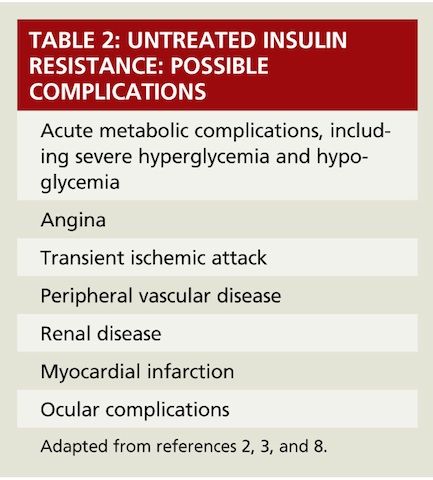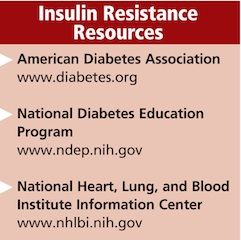
Publication
Article
Pharmacy Times
Insulin Resistance: Recognizing the Hidden Danger
Author(s):
Interventions to improve insulin sensitivity can go a long way toward improving overall health.
Interventions to improve insulin sensitivity can go a long way toward improving overall health.
Insulin resistance is clinically defined as the state in which a given concentration of insulin produces a less than expected biologic effect and, in turn, causes the body to not utilize insulin efficiently.1-3 In an effort to compensate for this defect, the pancreas releases additional amounts of insulin in an attempt to maintain normal blood glucose levels.1-3
Over time, the beta-cells, which are the insulin-producing cells in the pancreas, become less and less capable of meeting insulin demands.1-5 As a result, blood glucose levels begin to escalate, causing prediabetes and eventually type 2 diabetes.3
Some patients with type 2 diabetes have insulin resistance, whereas others have insulin deficiency.4,5 Many studies have showed, however, that insulin resistance alone does not cause diabetes without a subsequent decline in insulin production.4,5 Insulin resistance has also been defined by some health care professionals as the need for 200 or more units of insulin per day to control or maintain blood glucose levels or prevent ketosis (Table 1).1,2
In the United States, an estimated 60 to 70 million individuals are affected by insulin resistance. Statistics report that more than 40% of individuals older than 50 years may be at risk for insulin resistance; however, it can affect anyone at any age.3,6 Many health experts also believe that insulin resistance has a major role in the development of the metabolic syndrome (formerly known as syndrome X).7
Insulin resistance plays a significant role in the pathogenesis of other serious medical conditions as well, including obesity, hypertension, type 2 diabetes, dyslipidemia, and cardiovascular disease.2,8 The growing obesity epidemic in the United States continues to escalate the number of individuals at risk for developing insulin resistance, even in the pediatric patient population. Insulin resistance has also been linked to polycystic ovary syndrome (PCOS).8,9 Current studies suggest that 50% to 70% of women with PCOS have some degree of insulin resistance.10

Causes and Risk Factors
Although the cause of insulin resistance is complex and not fully understood, many factors/risks have been implicated as contributing to its development, including genetic and environmental factors; family history of diabetes; being overweight/obesity; sedentary lifestyle; ethnicity (African American, Hispanic, Asian); the aging process; stress; pregnancy; other medical conditions, such as Cushing’s syndrome, cirrhosis, and PCOS; and the use of certain pharmacologic agents, including cyclosporine, thiazide diuretics, niacin and protease inhibitors, and nucleoside analogues.2,5,8-11 Waist circumference greater than 35 inches in women and greater than 40 inches in men is considered a risk factor for insulin resistance as well.12
Symptoms of Insulin Resistance
Symptoms associated with insulin resistance vary among individuals. Many individuals with insulin resistance do not experience any symptoms until they present with a severe form of the condition.10,11,13 Some patients may present with unexplained weight gain.
Individuals with moderate to severe insulin resistance may present with a dermatologic condition referred to as acanthosis nigricans, which is characterized by dark patches of skin around the neck, armpits, knees, and elbows.10,11,13 Acanthosis nigricans occurs more frequently in Hispanics and African Americans than in Caucasians.10,11,13
Treating Insulin Resistance
The goals of treating insulin resistance are to improve insulin sensitivity, decrease health complications, improve overall health, and decrease morbidity and mortality.2 Lifestyle modifications, including dietary changes, weight loss, exercise, cessation or reduction of alcohol use, and cessation of smoking, are typically first lines of defense in managing insulin resistance.1,2,9-11
Although currently there are no FDA-approved medications specifically for the treatment of insulin resistance, the pharmacologic agents that are often prescribed for insulin resistance in some patients include metformin and the thiazolidinediones.14,15 Insulin is also used for some cases of insulin resistance.2
Metformin is classified as a biguanide, which is an insulin sensitizer that reduces hepatic glucose output and peripheral resistance to insulin action and lowers plasma insulin levels.2 Thiazolidinediones (pioglitazone and rosiglitazone) are classified as insulin-sensitizing agents that increase the disposal of glucose in peripheral tissues and act by activating a specific nuclear receptor, the peroxisome proliferator—activated receptor gamma.2 As of September 2010, the FDA is requiring a restricted access program to be developed for rosiglitazone under a Risk Evaluation and Mitigation Strategy.16 In addition, in June 2011, the FDA warned that use of pioglitazone for more than 1 year may be associated with an increased risk of bladder cancer.17,18
Conclusion
Insulin resistance affects several organ systems and, if left untreated, can lead to serious health consequences (Table 2). The results from the Diabetes Prevention Program (DPP) trial offers health care professionals with helpful guidance when encountering patients at risk for developing diabetes, including those with insulin resistance. Involving 3200 participants with impaired glucose tolerance, the DPP reported in part that strict and rigorous lifestyle interventions decreased the development of type 2 diabetes by 58%.19

Adhering to strict dietary modifications, implementing an exercise routine, and promoting weight loss can have a positive impact on the health of those patients affected by insulin resistance. Through patient education and screening patients at risk for insulin resistance, health care professionals can assist patients in improving their overall health and decrease the associated health consequences. Having a thorough understanding about insulin resistance, the complications, management, and prevention, patients can make informed decisions about their health and possibly live longer, healthier lives.

Ms. Terrie is a clinical pharmacy writer based in Haymarket, Virginia.
References
1. Lebovitz HE. Insulin resistance: definition and consequences. Exp Clin Endocrinol Diabetes. 2001;109(suppl 2):S135-S148.
2. Olatunbosun ST. Insulin resistance. Medscape website. http://emedicine.medscape.com/article/122501-overview. Accessed August 30, 2012.
3. About diabetes. American Heart Association website. www.heart.org/HEARTORG/Conditions/Diabetes/AboutDiabetes/About-Diabetes_UCM_002032_Article.jsp. Accessed August 29, 2012.
4. Bardsley JK, Magee MF. Pathophysiology of the metabolic disorder. In: Mensing C, ed. The Art and Science of Diabetes Self-Management Education. 2nd ed. Chicago, IL: American Association of Diabetes Educators; 2011.
5. Mitchell, M. Understanding insulin resistance. Nursing. 2012;42(3):62.
6. 2011 Diabetes Fact Sheet. Centers for Disease Control website. www.cdc.gov/diabetes/pubs/pdf/ndfs_2011.pdf. Accessed August 29, 2012.
7. Mathur R. Insulin resistance and the use of metformin: effects on body weight. Bariatric Times. 2011;8(1):10-12.
8. Diabetes mellitus. Merck Manual for Healthcare Professionals Online Edition. www.merckmanuals.com/professional/endocrine_and_metabolic_disorders/diabetes_mellitus_and_disorders_of_carbohydrate_metabolism/diabetes_mellitus_dm.html. Accessed August 28, 2012.
9. Futterweit W. A Patient’s Guide to PCOS: Understanding and Reversing Polycystic Ovarian Syndrome. New York, NY: Henry Holt and Company; 2006.
10. Polycystic ovary syndrome. United States Department of Health and Human Services website. www.nichd.nih.gov/publications/pubs/upload/PCOS_booklet.pdf. Accessed August 28, 2012.
11. Insulin resistance and prediabetes. National Diabetes Information Clearinghouse website. http://diabetes.niddk.nih.gov/dm/pubs/insulinresistance/#what. Accessed August 28, 2012.
12. All about insulin resistance. American Diabetes Association website. http://professional.diabetes.org/UserFiles/File/Make%20the%20Link%20Docs/CVD%20Toolkit/05-Insulin-Resistance.pdf. Accessed August 29, 2012.
13. Stuart CA, Peters EJ, Prince MJ, Richards G, Cavallo A, Meyer WJ 3rd. Insulin resistance with acanthosis nigricans: the roles of obesity and androgen excess. Metabolism. 1986;35(3):197-205.
14. Jensterle M, Janez A, Mlinar B, Marc J, Prezelj J, Pfeifer M. Impact of metformin and rosiglitazone treatment on glucose transporter 4 mRNA expression in women with polycystic ovary syndrome. Eur J Endocrinol. 2008;158(6):793-801.
15. Gebel E. Understanding insulin resistance. Diabetes Forecast. June 2011.
16. FDA drug safety communication: updated risk evaluation and mitigation strategy (REMS) to restrict access to rosiglitazone-containing medicines including Avandia, Avandamet, and Avandaryl. FDA website. www.fda.gov/Drugs/DrugSafety/ucm255005. Accessed August 29, 2012.
17. FDA Drug Safety Communication: update to ongoing safety review of Actos (pioglitazone) and increased risk of bladder cancer. FDA website. www.fda.gov/Drugs/DrugSafety/ucm259150. Accessed August 28, 2012.
18. Thiazolidinedione. National Diabetes Information Clearing House website. http://diabetes.niddk.nih.gov/dm/pubs/medicines_ez/insert_J.aspx. Accessed August 29, 2012.
19. Diabetes Prevention Program Research Group. The Diabetes Prevention Program: baseline characteristics of the randomized cohort. Diabetes Care. 2000;23:1619-1629.
20. Einhorn D, Reaven GM, Cobin RH, et al. American College of Endocrinology position statement on the insulin resistance syndrome. Endocr Pract. 2003;9(3):237-252.
21. American Association of Clinical Endocrinologists Position Statement on Metabolic and Cardiovascular Consequences of Polycystic Ovary Syndrome. Endocr Pract. 2005; 11(2):126-134.

2 Commerce Drive
Cranbury, NJ 08512
All rights reserved.





